This content originally appeared on Level Up Coding - Medium and was authored by Mohammed Vaghjipurwala
A Comprehensive Guide to Event-Driven Architectural Patterns
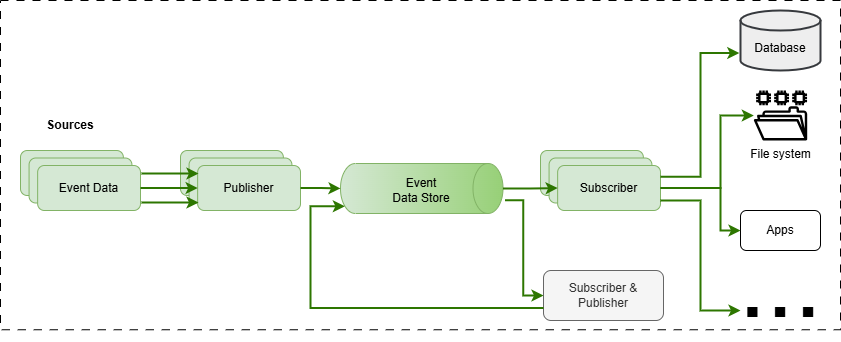
In today’s landscape of distributed systems and microservices, Event-Driven Architecture (EDA) has emerged as a powerful approach for building responsive, scalable, and resilient applications. By decoupling services and leveraging asynchronous communication, EDA makes it easier to handle complex workflows and unpredictable workloads. This guide dives into essential patterns in event-driven architecture and explores their use cases, along with practical tools for implementation.
“The success of a distributed system lies in its ability to handle events effectively, allowing the system to grow organically and adapt to change.” — Anonymous
🧩 What is Event-Driven Architecture?
Event-Driven Architecture revolves around events — notifications of state changes that are emitted by one component (producer) and processed by another (consumer). By decoupling event producers from consumers, systems can handle high loads and remain responsive. This asynchronous approach enables scalability and flexibility, especially in distributed environments where services need to interact efficiently.
Core Concepts of EDA
In EDA, three primary roles facilitate communication:
- Event Producers: These components generate and emit events whenever a change or action occurs. For example, an e-commerce site’s order system might produce an event when a new order is placed.
- Event Routers/Brokers: Middleware or brokers (like Kafka or RabbitMQ) distribute the events to relevant consumers. They handle the transport, routing, and potential storage of events, ensuring they reach their intended destination.
- Event Consumers: These are components or services that consume events to perform actions or trigger workflows. In the e-commerce example, a shipping service might consume the order event to initiate the packaging and delivery process.
The three main types of EDA are:
- Simple Event Processing: Basic pattern where events are simply tracked without complex handling.
- Event Stream Processing: Involves continuous flow and real-time processing of event data.
- Complex Event Processing (CEP): Analyzes patterns across multiple event streams to detect intricate conditions and trigger complex workflows.
How Event-Driven Architecture Works
Here’s a step-by-step breakdown of how EDA operates:
- Event Occurrence: When something meaningful happens in the system, such as a user action or system trigger, an event is created by the producer. This event contains data and metadata to describe the occurrence.
- Event Emission: The event is emitted and published to an event router or broker. The router typically provides infrastructure that reliably stores, routes, and forwards events to registered consumers.
- Event Routing and Processing: The broker routes the event to interested consumers. Some architectures also involve filters or message queues to manage how events are distributed.
- Consumer Response: Consumers process the event, triggering actions or workflows. For example, an analytics service might log the event for trend analysis, while another service updates related systems. Once processed, some events can initiate new workflows, creating a chain of reactions throughout the architecture.
- Event-Driven Workflow: In complex cases, multiple services may collaborate, using events as triggers to work together, handle failures, and maintain consistency across distributed transactions.
Core Event-Driven Patterns
🔹 Competing Consumer Pattern
The Competing Consumer Pattern allows multiple consumers to process events from a shared queue, distributing the load among them. Consumers compete to handle events as they arrive, balancing the workload and enhancing throughput by allowing parallel processing.
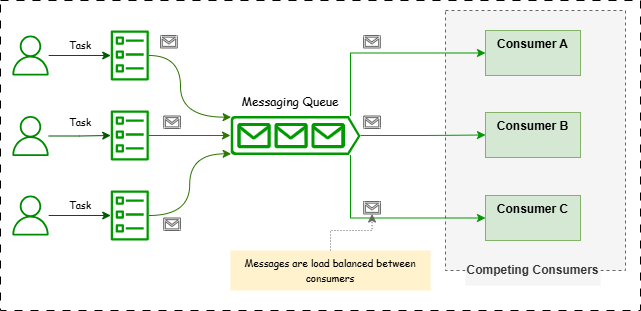
📌 Example
In a Competing Consumer pattern for video encoding, uploaded videos are added to a queue as encoding tasks. Multiple encoding services (consumers) then retrieve and process these tasks concurrently, balancing the workload and speeding up overall processing times. This setup ensures faster, efficient handling of high video upload volumes.
🎯 Use Cases:
- Task Processing: Distributing tasks like video encoding or data processing.
- Load Balancing: Managing heavy workloads by spreading them across multiple instances.
🛠️ Tools:
- RabbitMQ: An effective message broker for implementing competing consumers.
- Amazon SQS: A fully managed queuing service for horizontal scaling.
🔹 Consume and Project Pattern
In this pattern, the system consumes events and projects the data into new formats or aggregated models. This is useful for transforming raw data into meaningful insights, ready for analysis or further action.

📌 Example
In the Consume and Project pattern, when an order is created, the Order Service emits an Order Creation event. The Order Projection Service consumes this event, updating a materialized view with enriched order data for fast, optimized access. Additionally, the Order Projection Service sends enriched data to the Customer Service, which updates the Customer Database with new order-related details, like recent purchase history, enhancing the customer’s profile for future interactions. This enables efficient data transformation and streamlined updates across services.
🎯 Use Cases:
- Data Transformation: Making raw data usable for reporting.
- Real-Time Analytics: Providing aggregated data for dashboards and insights.
🛠️ Tools:
- Kafka Streams: A stream-processing library that allows for data transformation.
- Apache Flink: A robust engine for real-time stream processing and projection.
🔹 Event Sourcing Pattern
Event Sourcing involves capturing each change to a system as an event, allowing the system’s state to be reconstructed by replaying the entire event history. This pattern offers full traceability and enables the rebuilding of the system state at any time.
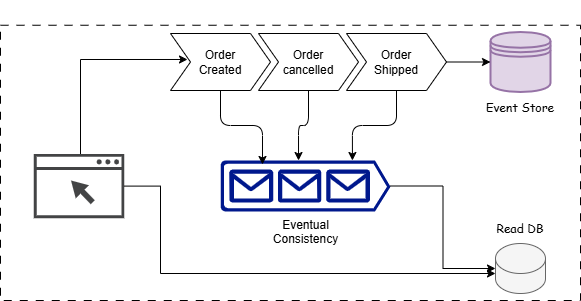
📌 Example
In the Event Sourcing pattern, every change to an order’s state is stored as an event, creating an auditable history. For example, when an order is placed, an Order Created event is saved, recording initial details. As the order progresses, an Order Shipped event is logged, capturing shipping information. If the order is later canceled, an Order Canceled event is added. By replaying these events, the system can reconstruct the order’s history or current state at any time, ensuring a clear, traceable record.
🎯 Use Cases:
- Auditing: Keeping a complete history of all events for traceability.
- State Reconstruction: Rebuilding current state from event history if needed.
🛠️ Tools:
- EventStoreDB: A database built specifically for event sourcing.
- Axon Framework: Supports event sourcing and distributed event handling.
🔹 Async Task Execution Pattern
The Async Task Execution Pattern is ideal for offloading time-consuming or resource-intensive tasks to be processed in the background. This ensures that the main application remains responsive while secondary tasks run asynchronously.
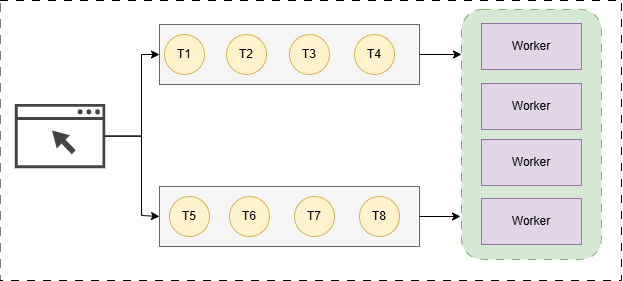
📌 Example
In an Async Task Execution pattern for an e-commerce site, tasks like payment processing, inventory updates, and order confirmation are handled asynchronously after a user places an order. This allows the site to remain fast and responsive for the user, while background services complete each step independently.
🎯 Use Cases:
- Non-blocking Operations: Handling long-running tasks without blocking the main workflow.
- Background Processing: For tasks like sending emails, generating reports, or data processing.
🛠️ Tools:
- AWS Lambda: Executes functions asynchronously in response to events.
- Celery: A Python distributed task queue for handling asynchronous tasks.
🔹 Transactional Outbox Pattern
The Transactional Outbox Pattern ensures data consistency when publishing events by using a transactional “outbox” table. Events are stored in the outbox table within the same transaction as the primary data, then sent to consumers only after a successful commit.
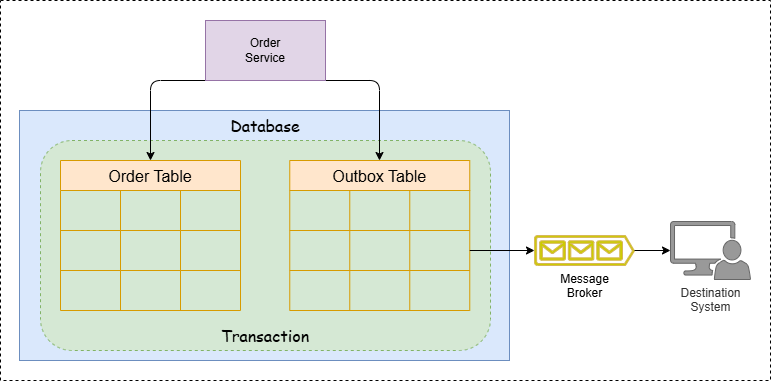
📌 Example
In a Transactional Outbox pattern for an order management system, when an order is recorded, a corresponding event is stored in an outbox within the same transaction. Once the transaction is successfully committed, the event is published to notify inventory and shipping services, ensuring data consistency across all services.
🎯 Use Cases:
- Consistent Event Publishing: Ensuring that events are published reliably.
- Microservice Synchronization: Maintaining consistency across distributed services.
🛠️ Tools:
- Debezium: Captures database changes and synchronizes them with Kafka.
- Kafka Connect: Publishes events from an outbox table to Kafka topics.
🔹 Event Aggregation Pattern
The Event Aggregation Pattern gathers and combines multiple events, producing a single event for further processing. This is useful for cases where actions are based on the outcome of multiple related events.
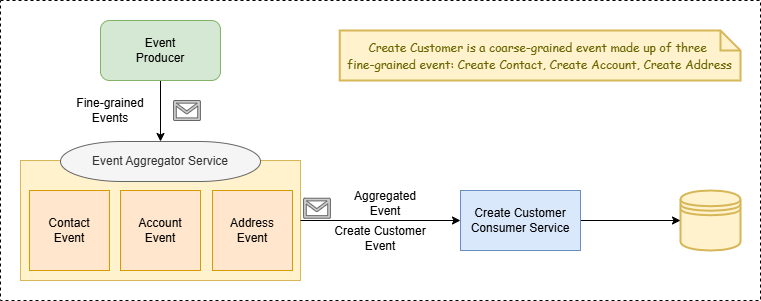
📌 Example
In an Event Aggregator setup for customer creation, a single Create Customer event is split into three finer events: Create Contact, Create Account, and Create Address. Each event is handled by a specialized service, which processes its part independently — adding contact details, setting up the account, and recording the address. The Event Aggregator consolidates these events, ensuring all parts are complete before confirming the customer creation. This allows for modular, reliable processing across services.
🎯 Use Cases:
- Cross-Service Workflow: Aggregating data from multiple services to trigger workflows.
- Real-Time Monitoring: Combining log events for unified insights.
🛠️ Tools:
- AWS Step Functions: Enables event aggregation for orchestrating workflows.
- Apache Flink: A real-time stream processor for event aggregation.
🔹 Saga Pattern
The Saga Pattern manages distributed transactions by breaking them into a sequence of smaller, isolated steps. Each step emits an event and, in the event of failure, triggers compensating actions to maintain data consistency.
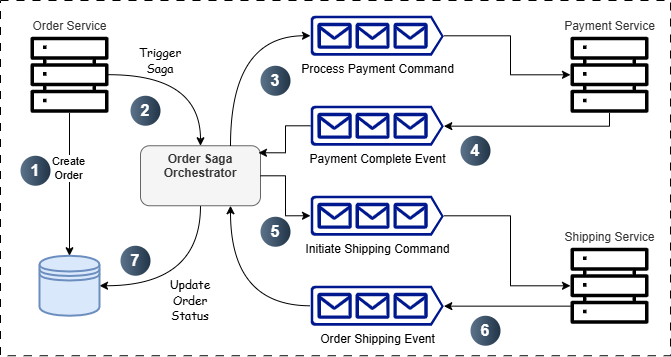
📌 Example
In an e-commerce system, the Saga Pattern coordinates the order process across multiple services. First, the Order Service creates the order, storing it in the database and triggering the Saga Orchestrator. The orchestrator then sends a payment command to the Payment Service and, upon completion, initiates shipping through the Shipping Service. Finally, once the order is shipped, the saga updates the order status in the database. This approach ensures smooth, consistent transaction flow and handles any failures with compensating actions.
🎯 Use Cases:
- Distributed Transactions: Coordinating transactions across multiple services.
- Fault Tolerance: Maintaining consistency even when certain operations fail.
🛠️ Tools:
- Axon Framework: Supports the implementation of sagas with event-driven systems.
- Camunda: A workflow engine for managing complex transactions.
🎯 Real-World Use Cases for Event-Driven Architecture
- E-Commerce: Retail platforms use Competing Consumer and Async Task Execution Patterns to handle large volumes of orders while maintaining system responsiveness.
- Financial Services: Banks leverage Event Sourcing and Saga Patterns to ensure transaction integrity and traceability across multiple systems.
- IoT Systems: Smart homes and industrial IoT platforms utilize Event Aggregation to process and analyze sensor data in real time.
- Travel and Booking: Travel applications rely on Transactional Outbox and Saga Patterns to ensure all booking components (flights, hotels, rentals) are synchronized and consistent.
📈 Pros and Cons of Event-Driven Architecture
Pros of EDA
- Scalability: EDA supports distributed and microservices architectures, making it easy to scale individual services based on demand.
- Resilience and Fault Tolerance: EDA minimizes tight coupling, meaning that the failure of one component often does not directly impact others. Event routers can buffer events if consumers are temporarily unavailable, enhancing fault tolerance.
- Asynchronous Processing: Events enable background processing, allowing the system to handle user requests promptly without waiting for downstream tasks to complete. This leads to lower latency and a more responsive user experience.
- Flexibility and Extensibility: New event consumers or services can be added without changing the event producers, making it easy to expand the system and integrate additional capabilities.
- Real-Time Data Processing: For applications requiring real-time insights (e.g., analytics, monitoring), EDA enables continuous processing and immediate response to events.
Cons of EDA
- Increased Complexity: EDA introduces additional architectural complexity with more components and the need for coordination between services. This can complicate both development and debugging.
- Difficulty in Ensuring Data Consistency: In distributed systems, consistency is challenging to maintain, especially in cases where events are processed out of order or duplicated.
- Latency in Event Delivery: While EDA can reduce application latency, certain events may still experience delays in being delivered or processed, especially in large systems with many consumers.
- Error Handling and Event Management: Handling failures and ensuring all events are processed correctly requires careful management. Some architectures (like Saga or compensating transactions) address this, but it increases complexity.
- Potential for Data Duplication: With many services producing and consuming events independently, there’s a risk of duplicating data, leading to inefficiencies if not carefully managed.
- Testing and Debugging Challenges: Asynchronous and distributed environments can be challenging to troubleshoot, with many moving parts to monitor and test.
🔍 Conclusion
Event-driven architecture offers a powerful model for modern applications needing scalability, flexibility, and fault tolerance. By implementing key patterns like Competing Consumer, Event Sourcing, and Saga, organizations can build systems that respond effectively to real-time events while maintaining data integrity and consistency. However, careful consideration is required to manage complexity and ensure effective event handling.
🛠️ References
“Learning never exhausts the mind; it only expands it.” — Leonardo da Vinci
Thanks for reading! I hope this exploration into Event-Driven Architecture patterns added value to your journey. Feel free to share your thoughts, ask questions, or leave constructive feedback 💬below. And if you enjoyed this, a clap 👏 is always appreciated!
Keep learning, keep growing.
Architecting for Scale: Key Event-Driven Patterns You Need to Know was originally published in Level Up Coding on Medium, where people are continuing the conversation by highlighting and responding to this story.
This content originally appeared on Level Up Coding - Medium and was authored by Mohammed Vaghjipurwala
Mohammed Vaghjipurwala | Sciencx (2024-11-07T01:20:23+00:00) Architecting for Scale: Key Event-Driven Patterns You Need to Know. Retrieved from https://www.scien.cx/2024/11/07/architecting-for-scale-key-event-driven-patterns-you-need-to-know/
Please log in to upload a file.
There are no updates yet.
Click the Upload button above to add an update.
